As Valentine’s Day approaches yet again, the familiar accoutrements appear as well: fancy chocolates in fancy heart-shaped boxes, valentine cards bought from either a boutique stationery store or a supermarket card section, red roses 30% off at the local florist, etc. Why are all of these things associated with love, romance and sex? Do they have anything to do with Valentine’s Day? For that matter, what is Valentine’s Day, even? Is all of this just fake shit made up by corporations to make a quick buck by exploiting feelings of affection every February 14?
Yeah, basically.
Let’s start from the beginning, in Victorian England, where the commercialization of Valentine’s Day got its start. According to Dr. Sally Holloway, gender and material culture historian at Oxford Brookes University, Valentine’s Day shifted from a folk tradition to a commercial holiday replete with pre-printed valentine cards—as well as a popular revolt against that same process of commercialization.
In her article “Love, Custom & Consumption: Valentine’s Day in England c.1660–1830” published in the journal Cultural and Social History, Holloway traces the material history of Valentine’s Day and the ways in which the commercialization of the holiday has challenged and influenced how we experience love. Originally, Valentine’s Day celebrations consisted of valentine’s “lotteries” and gift exchanges, as well as the practice of children going door to door soliciting either food or money, saying, “good morrow to you, Valentine.” This type of celebration is certainly nothing like modern Valentine’s Day.
The traditions began to shift, Holloway writes, in the second half of the 18th century. Lotteries and gift exchanges were slowly replaced by the exchange of paper valentines. By 1780, one could buy a “valentine writer”—essentially a pamphlet with various poems and short stories about love and romance—that one could copy into their handwritten valentine card. By the 1790s, pre-printed valentines were widely available in stores. Here we can see the first steps that Valentine’s Day took away from a community tradition and toward a commercial holiday.
Valentine’s Day was not alone in this shift. The popularity of printed goods exploded in the eighteenth century, with pre-written greeting cards, satirical prints, trade cards and more becoming widespread. This proliferation of printed goods mirrored the larger social and economic trends of the Industrial Revolution, where machines were seemingly churning out uniform products left and right.
Not all people followed the trend of premade cards. In fact, it became somewhat of a badge of honor to make handmade valentines, as members of every class and social status chose to write their own cards, tie their own lovers’ knots and fold their own puzzle purses. This “self-consciously archaic languag[e] of love,” as Holloway puts it, was a response to the commercialization of romantic culture and the impersonal nature of modern love.
Handmade valentines, often made by urban poets and other city dwellers, extolled the virtues of rural living. These “pastorals” used deliberately archaic language and imagery—things associated with ancient knights, troubadours, country cottages and the like—as a contrast to their present material conditions. Holloway argues these valentines had a dialectical relationship between urban and rural: between the thesis of industrial capitalism and the antithesis of an earlier, medieval age. The advent of capitalism had severed the traditional relationship between craftsmen and the individual means of production, instead transforming each person into a wage worker with no connection to the goods they produced. Handmade cards harkening back to a sentimentalized past were simply a natural response to this historical development.
So that’s the history of valentine cards; what about chocolates? Here we can see a similar story to valentine cards. Richard Cadbury, co-owner of the Cadbury chocolate company, decided in 1861 to market heart-shaped chocolate boxes covered in Cupids and rosebuds for Valentine’s Day. In Victorian England, Cupid imagery was already immensely popular, and Valentine’s Day had long since become a commercial holiday. But what Cadbury did inextricably linked chocolate to Valentine’s Day, and forever reinforced the connection between chocolate and romance.
The heart-shaped boxes Cadbury sold were designed to last long enough to hold valentine cards and other romantic mementos—which conveniently doubled as free marketing for Cadbury the longer the box stayed in the house. Other chocolatiers quickly jumped on the trend; Milton Hershey actually switched his business from caramel to chocolate-making in 1894, and in 1907 he introduced the famous Hershey Kiss. Russell Stover, now one of the biggest chocolate sellers in the world, makes bank every year on its “Secret Lace Heart” box of chocolates.
According to the National Retail Federation’s 2021 Valentine’s Day spending survey, consumers each plan to spend an average of $164.76 on their loved ones this February 14. In total, they project around $21 billion will be spent on various Valentine’s Day gifts and expenses. Valentine’s Day, like most other holidays, is a cash cow.
In the age of international capitalism, it would be silly to think of Valentine’s Day as restricted to England and the United States, or even the English-speaking world. Valentine’s Day has spread to almost every country on the globe, and its reception has been more positive in some places than others.
In Japan, for example, Valentine’s Day was popularized by confectioners who began to market heart-shaped chocolate boxes in the 1930s. As a result, you don’t give any cards or flowers or jewelry to your significant other on Valentine’s Day; you only give them chocolates, and lots of them. Furthermore, women are expected to give chocolates to men on February 14, not the other way around.
In the 1980s, the Japanese National Confectionery Association successfully lobbied for “White Day,” a holiday on March 14 where men reply to women’s gifts from Valentine’s Day and give them chocolate in return. Men are expected to give women a gift that’s worth about two to three times the one they received in February; coincidentally, Japanese chocolate shops make around 70% of their annual income in the lead-up to Valentine’s Day and White Day.
In contrast, in 2003, protests against Valentine’s Day in Bombay sparked violence after Hindu and Muslim activists called for the banning of the holiday and members of the right-wing group Shiv Sena raided some stores selling valentine cards. One Shiv Sena leader said of the holiday, “[Valentine’s Day] is nothing but a Western onslaught on India’s culture to attract youth for commercial purposes.”
The Indian left has its criticisms of the holiday too: Professor Satya P. Sharma sees Valentine’s Day as an outgrowth of the “liberalization and globalization” of India’s economy, the “inevitable fallout of the distinct global mass identity forged by television” in the world capitalist system.
One can celebrate Valentine’s Day as a simple holiday meant to kindle romance and bring out expressions of love. But before you celebrate this year, consider: do you celebrate the way you do because it truly expresses your feelings? Or have you been conditioned to consume for consumption’s sake? Has the commercialization of Valentine’s Day shaped how you experience romance?





